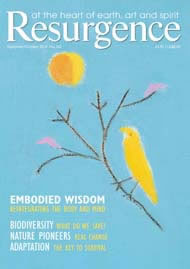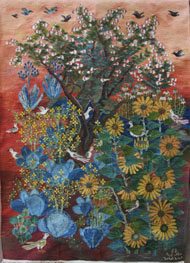Born and educated in Egypt, Ramses Wissa Wassef trained in Paris as an architect before the Second World War. Disturbed by the coldness and ugliness of modern western architecture, he grew concerned about its unthinking adoption in other countries and cultures. When he returned to Egypt, Wissa Wassef paid close attention to indigenous styles of architecture and became increasingly interested in periods of history when craftsmen were respected and prosperous members of society. This led him to conclude that the conventional distinction between the "artist" who creates and the "craftsman" who merely executes was prejudicial to creativity. He also observed that although every child is moved to express him or herself in drawing from the earliest age, this urge is almost always smothered once formal education begins. He later wrote: "I had this vague conviction that every human being was born an artist but that his gifts could be brought out only if artistic activity was encouraged from early childhood by way of practising a craft."
In 1941, Wissa Wassef was commissioned to design a primary school in one of the oldest quarters of Cairo. When the building was finished, he obtained permission to teach some of the pupils the craft of high warp weaving after school hours. As soon as they had mastered the basic technique, he left the children free to decide what images to produce. He insisted on only three rules: no sketches; no external aesthetic influences; and no critical interference from adults.
Encouraged by the success of this project, Wissa Wassef and his wife purchased some land on the edge of the village of Harrania, 10 miles from Cairo and within sight of the pyramids of Giza, in 1952. Having built a workshop, they installed some primitive looms and invited any village child who wished to do so - and whose parents consented - to come once a week to learn to weave. Thus was the “art centre” was established.
Just as in Cairo, the Harrania children were left to weave whatever they liked, guided by their innate creative talent and drawing inspiration from within themselves and their environment. Protected from external aesthetic influences, adult criticism and interference, the children were given the benefit of time in which to develop their skills and individuality. Wissa Wassef's aim was to ensure that "these young artists have only their own conception of their work, drawn from their own experience. ….. They know nothing of the hesitation of sophisticated artists …. who are continually tempted to express themselves in the style of some other artist”.
Ramses Wissa Wassef's modest experiment in Harrania rapidly demonstrated, without exception, that any child was able to create works of astonishing beauty. As he explained, “these children were not selected for any special qualities they may have possessed. I can confirm, however, that no child is devoid of the most surprising gifts."
In the 50 years since weaving began in Harrania, it has become clear that this innate creativity can grow with the child into adolescence and adulthood. Not long before Wissa Wassef’s death in 1974, a second generation of young villagers mastered the craft of weaving.
Although the Art Centre has greatly expanded since 1952, its fundamental spirit and guiding philosophy remain alive. They are embodied in the very fabric of the Centre. All the buildings, initially designed by Ramses and later by his widow Sophie, are of dome and vault construction – for which Ramses posthumously received the prestigious Aga Khan Award for Architecture. At the northern edge of the garden is a large museum, completed in 1989, whose permanent collection of tapestries shows the development of individual weavers from the first days of the experiment. Under the guidance of Sophie and her daughters, Suzanne and Yoanne, the "experiment" has gone from strength to strength.
The artistic products of The Ramses Wissa Wassef Art Centre are not its only contribution to Egypt and the world. The weavers are the pride of the community. The project has transformed the lives of poor, illiterate villagers, bringing prosperity, education, better health, self-respect and satisfaction to all and high status to the women. The Wissa Wassefs encouraged the first generation weavers to attend reading and writing classes and the second generation to remain at school until the age of 16. They arranged for a private doctor to visit the Centre twice each week to help combat bilharzia, stomach illnesses and other, then widespread, problems. By 1963 all the weavers had joined the Egyptian government's national health plan.
The success of the Art Centre made an impact far beyond Harrania. It inspired commercial entrepreneurs to introduce the craft of hand-weaving in many parts of Egypt, giving employment to hundreds of young men and women. Suzanne Wissa Wassef’s husband, Ikram Nosshi, continued his father-in-law’s pioneering architectural work, providing job opportunities in Egypt’s building industry and inspiring others as far away as Australia to build in a similar style.
It is, however, for the remarkable results of the experiment in creativity that Ramses Wissa Wassef, and the Art Centre which bears his name are principally renowned. Many major exhibitions in the USA and Europe have helped bring these works of art to international attention and in so doing have help the Art Centre to be self-sustaining.
An exhibition of new tapestries will be held from 24 November until 5th December 2010 at 3 Bedfordbury, Covent Garden, London WC2N 4BP.








